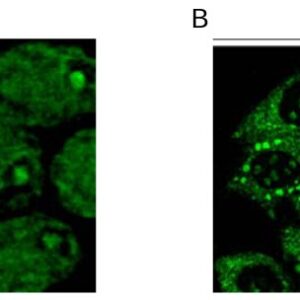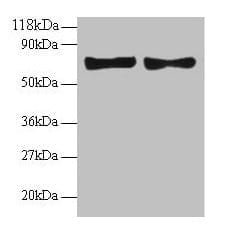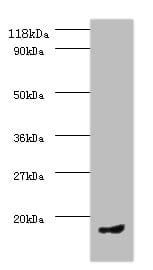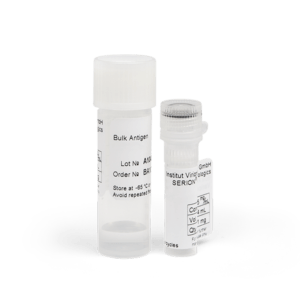| Weight | 1 lbs |
|---|---|
| Dimensions | 9 × 5 × 2 in |
| host | rabbit |
| isotype | IgG |
| clonality | polyclonal |
| concentration | 1 mg/mL |
| applications | ICC/IF, WB |
| reactivity | PDK1 (Phospho-Ser241) |
| available sizes | 100 µL |
rabbit anti-PDK1 (Phospho-Ser241) polyclonal antibody 7422
$366.00
Antibody summary
- Rabbit polyclonal to PDK1 (Phospho-Ser241)
- Suitable for: WB,IHC
- Isotype: Whole IgG
- 100 µl
rabbit anti-PDK1 (Phospho-Ser241) polyclonal antibody 7422
| antibody |
|---|
| Tested applications WB,IHC,IHC |
| Recommended dilutions Western blotting: use at dilution of 1:500- 1:1,000. A band of ~63kDa is detected. Immunohistochemistry: use at dilution of 1:50- 1:100. These are recommended working dilutions. End user should determine optimal dilutions for their applications. |
| Immunogen Peptide sequence that includes phosphorylation site of Serine 241 (A-N-S(p)-F-V) derived from human PDK1 and conjugated to KLH. |
| Size and concentration 100µL and 1 mg/mL |
| Form liquid |
| Storage Instructions This antibody is stable for at least one (1) year at -20°C. |
| Storage buffer PBS (without Mg2 and Ca2 ), pH 7.4, 150mM NaCl, |
| Purity affinity purified |
| Clonality polyclonal |
| Isotype IgG |
| Compatible secondaries goat anti-rabbit IgG, H&L chain specific, peroxidase conjugated, conjugated polyclonal antibody 9512 goat anti-rabbit IgG, H&L chain specific, biotin conjugated polyclonal antibody 2079 goat anti-rabbit IgG, H&L chain specific, FITC conjugated polyclonal antibody 7863 goat anti-rabbit IgG, H&L chain specific, Cross Absorbed polyclonal antibody 2371 goat anti-rabbit IgG, H&L chain specific, biotin conjugated polyclonal antibody, crossabsorbed 1715 goat anti-rabbit IgG, H&L chain specific, FITC conjugated polyclonal antibody, crossabsorbed 1720 |
| Isotype control Rabbit polyclonal - Isotype Control |
| target relevance |
|---|
| Protein names 3-phosphoinositide-dependent protein kinase 1 (hPDK1) (EC 2.7.11.1) |
| Gene names PDPK1,PDPK1 PDK1 |
| Protein family Protein kinase superfamily, AGC Ser/Thr protein kinase family, PDPK1 subfamily |
| Mass 63152Da |
| Function FUNCTION: Serine/threonine kinase which acts as a master kinase, phosphorylating and activating a subgroup of the AGC family of protein kinases (PubMed:10226025, PubMed:10480933, PubMed:10995762, PubMed:12167717, PubMed:14585963, PubMed:14604990, PubMed:16207722, PubMed:16251192, PubMed:17327236, PubMed:17371830, PubMed:18835241, PubMed:9094314, PubMed:9368760, PubMed:9445476, PubMed:9445477, PubMed:9707564, PubMed:9768361). Its targets include: protein kinase B (PKB/AKT1, PKB/AKT2, PKB/AKT3), p70 ribosomal protein S6 kinase (RPS6KB1), p90 ribosomal protein S6 kinase (RPS6KA1, RPS6KA2 and RPS6KA3), cyclic AMP-dependent protein kinase (PRKACA), protein kinase C (PRKCD and PRKCZ), serum and glucocorticoid-inducible kinase (SGK1, SGK2 and SGK3), p21-activated kinase-1 (PAK1), TSSK3, protein kinase PKN (PKN1 and PKN2) (PubMed:10226025, PubMed:10480933, PubMed:10995762, PubMed:12167717, PubMed:14585963, PubMed:14604990, PubMed:16207722, PubMed:16251192, PubMed:17327236, PubMed:17371830, PubMed:18835241, PubMed:9094314, PubMed:9368760, PubMed:9445476, PubMed:9707564, PubMed:9768361). Plays a central role in the transduction of signals from insulin by providing the activating phosphorylation to PKB/AKT1, thus propagating the signal to downstream targets controlling cell proliferation and survival, as well as glucose and amino acid uptake and storage (PubMed:10226025, PubMed:12167717, PubMed:9094314). Negatively regulates the TGF-beta-induced signaling by: modulating the association of SMAD3 and SMAD7 with TGF-beta receptor, phosphorylating SMAD2, SMAD3, SMAD4 and SMAD7, preventing the nuclear translocation of SMAD3 and SMAD4 and the translocation of SMAD7 from the nucleus to the cytoplasm in response to TGF-beta (PubMed:17327236). Activates PPARG transcriptional activity and promotes adipocyte differentiation (By similarity). Activates the NF-kappa-B pathway via phosphorylation of IKKB (PubMed:16207722). The tyrosine phosphorylated form is crucial for the regulation of focal adhesions by angiotensin II (PubMed:14585963). Controls proliferation, survival, and growth of developing pancreatic cells (By similarity). Participates in the regulation of Ca(2+) entry and Ca(2+)-activated K(+) channels of mast cells (By similarity). Essential for the motility of vascular endothelial cells (ECs) and is involved in the regulation of their chemotaxis (PubMed:17371830). Plays a critical role in cardiac homeostasis by serving as a dual effector for cell survival and beta-adrenergic response (By similarity). Plays an important role during thymocyte development by regulating the expression of key nutrient receptors on the surface of pre-T cells and mediating Notch-induced cell growth and proliferative responses (By similarity). Provides negative feedback inhibition to toll-like receptor-mediated NF-kappa-B activation in macrophages (By similarity). {ECO:0000250|UniProtKB:Q9Z2A0, ECO:0000269|PubMed:10226025, ECO:0000269|PubMed:10480933, ECO:0000269|PubMed:10995762, ECO:0000269|PubMed:12167717, ECO:0000269|PubMed:14585963, ECO:0000269|PubMed:14604990, ECO:0000269|PubMed:16207722, ECO:0000269|PubMed:16251192, ECO:0000269|PubMed:17327236, ECO:0000269|PubMed:17371830, ECO:0000269|PubMed:18835241, ECO:0000269|PubMed:9094314, ECO:0000269|PubMed:9368760, ECO:0000269|PubMed:9445476, ECO:0000269|PubMed:9445477, ECO:0000269|PubMed:9707564, ECO:0000269|PubMed:9768361}.; FUNCTION: [Isoform 3]: Catalytically inactive. {ECO:0000269|PubMed:9445477}. |
| Catalytic activity CATALYTIC ACTIVITY: Reaction=L-seryl-[protein] + ATP = O-phospho-L-seryl-[protein] + ADP + H(+); Xref=Rhea:RHEA:17989, Rhea:RHEA-COMP:9863, Rhea:RHEA-COMP:11604, ChEBI:CHEBI:15378, ChEBI:CHEBI:29999, ChEBI:CHEBI:30616, ChEBI:CHEBI:83421, ChEBI:CHEBI:456216; EC=2.7.11.1; Evidence={ECO:0000269|PubMed:9368760}; CATALYTIC ACTIVITY: Reaction=L-threonyl-[protein] + ATP = O-phospho-L-threonyl-[protein] + ADP + H(+); Xref=Rhea:RHEA:46608, Rhea:RHEA-COMP:11060, Rhea:RHEA-COMP:11605, ChEBI:CHEBI:15378, ChEBI:CHEBI:30013, ChEBI:CHEBI:30616, ChEBI:CHEBI:61977, ChEBI:CHEBI:456216; EC=2.7.11.1; Evidence={ECO:0000269|PubMed:9368760}; |
| Subellular location SUBCELLULAR LOCATION: Cytoplasm. Nucleus. Cell membrane; Peripheral membrane protein. Cell junction, focal adhesion. Note=Tyrosine phosphorylation seems to occur only at the cell membrane. Translocates to the cell membrane following insulin stimulation by a mechanism that involves binding to GRB14 and INSR. SRC and HSP90 promote its localization to the cell membrane. Its nuclear localization is dependent on its association with PTPN6 and its phosphorylation at Ser-396. Restricted to the nucleus in neuronal cells while in non-neuronal cells it is found in the cytoplasm. The Ser-241 phosphorylated form is distributed along the perinuclear region in neuronal cells while in non-neuronal cells it is found in both the nucleus and the cytoplasm. IGF1 transiently increases phosphorylation at Ser-241 of neuronal PDPK1, resulting in its translocation to other cellular compartments. The tyrosine-phosphorylated form colocalizes with PTK2B in focal adhesions after angiotensin II stimulation. |
| Tissues TISSUE SPECIFICITY: Appears to be expressed ubiquitously. The Tyr-9 phosphorylated form is markedly increased in diseased tissue compared with normal tissue from lung, liver, colon and breast. {ECO:0000269|PubMed:18024423}. |
| Structure SUBUNIT: Homodimer in its autoinhibited state. Active as monomer. Interacts with NPRL2, PPARG, PAK1, PTK2B, GRB14, PKN1 (via C-terminus), STRAP and IKKB. The Tyr-9 phosphorylated form interacts with SRC, RASA1 and CRK (via their SH2 domains). Interacts with SGK3 in a phosphorylation-dependent manner. The tyrosine-phosphorylated form interacts with PTPN6. The Ser-241 phosphorylated form interacts with YWHAH and YWHAQ. Binds INSR in response to insulin. Interacts (via PH domain) with SMAD3, SMAD4 and SMAD7. Interacts with PKN2; the interaction stimulates PDPK1 autophosphorylation, its PI(3,4,5)P3-dependent kinase activity toward 'Ser-473' of AKT1 but also activates its kinase activity toward PRKCD and PRKCZ. {ECO:0000269|PubMed:10226025, ECO:0000269|PubMed:10995762, ECO:0000269|PubMed:12177059, ECO:0000269|PubMed:14585963, ECO:0000269|PubMed:14604990, ECO:0000269|PubMed:15210700, ECO:0000269|PubMed:16207722, ECO:0000269|PubMed:16251192, ECO:0000269|PubMed:16314505, ECO:0000269|PubMed:17327236, ECO:0000269|PubMed:18024423, ECO:0000269|PubMed:18616680, ECO:0000269|PubMed:19591923, ECO:0000269|PubMed:20978239}. |
| Post-translational modification PTM: Phosphorylation on Ser-241 in the activation loop is required for full activity. PDPK1 itself can autophosphorylate Ser-241, leading to its own activation. Autophosphorylation is inhibited by the apoptotic C-terminus cleavage product of PKN2 (By similarity). Tyr-9 phosphorylation is critical for stabilization of both PDPK1 and the PDPK1/SRC complex via HSP90-mediated protection of PDPK1 degradation. Angiotensin II stimulates the tyrosine phosphorylation of PDPK1 in vascular smooth muscle in a calcium- and SRC-dependent manner. Phosphorylated on Tyr-9, Tyr-373 and Tyr-376 by INSR in response to insulin. Palmitate negatively regulates autophosphorylation at Ser-241 and palmitate-induced phosphorylation at Ser-529 and Ser-501 by PKC/PRKCQ negatively regulates its ability to phosphorylate PKB/AKT1. Phosphorylation at Thr-354 by MELK partially inhibits kinase activity, the inhibition is cooperatively enhanced by phosphorylation at Ser-394 and Ser-398 by MAP3K5. {ECO:0000250, ECO:0000269|PubMed:10455013, ECO:0000269|PubMed:11481331, ECO:0000269|PubMed:14585963, ECO:0000269|PubMed:15743829, ECO:0000269|PubMed:16314505, ECO:0000269|PubMed:16780920, ECO:0000269|PubMed:22544756, ECO:0000269|Ref.8}.; PTM: Autophosphorylated; autophosphorylation is inhibited by the apoptotic C-terminus cleavage product of PKN2. {ECO:0000250}.; PTM: Monoubiquitinated in the kinase domain, deubiquitinated by USP4. |
| Domain DOMAIN: The PH domain plays a pivotal role in the localization and nuclear import of PDPK1 and is also essential for its homodimerization.; DOMAIN: The PIF-pocket is a small lobe in the catalytic domain required by the enzyme for the binding to the hydrophobic motif of its substrates. It is an allosteric regulatory site that can accommodate small compounds acting as allosteric inhibitors. {ECO:0000305|PubMed:22999883}. |
| Target Relevance information above includes information from UniProt accession: O15530 |
| The UniProt Consortium |
Data
| No results found |
Publications
| pmid | title | authors | citation |
|---|---|---|---|
| We haven't added any publications to our database yet. | |||
Protocols
| relevant to this product |
|---|
| Western blot IHC |
Documents
| # | SDS | Certificate | |
|---|---|---|---|
| Please enter your product and batch number here to retrieve product datasheet, SDS, and QC information. | |||
Only logged in customers who have purchased this product may leave a review.








Reviews
There are no reviews yet.